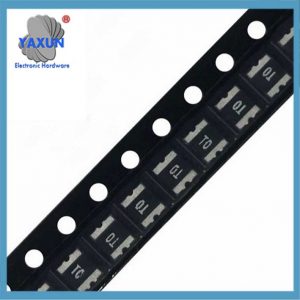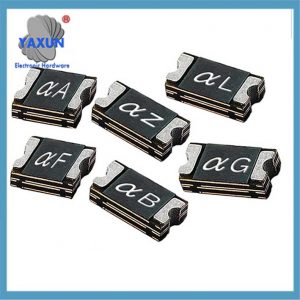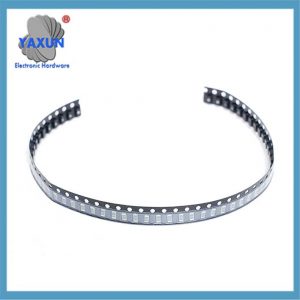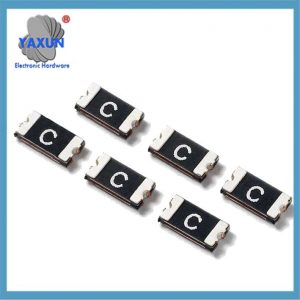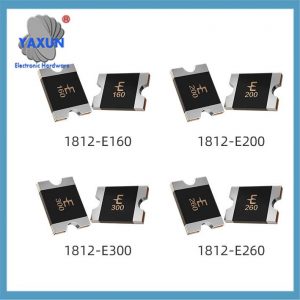Een hervestbare chipzekering, ook bekend als een PTC (Positieve temperatuurcoëfficiënt) hervesteerbare zekering, is een type oppervlaktemontageapparaat (SMD) Dat beschermt elektronische circuits tegen overstroom en oververhitting. Het werkt als een traditionele zekering, maar kan zichzelf automatisch resetten nadat een fout is gewist. Wanneer een fout als een overstroom of kortsluiting optreedt, De weerstand van de zekering neemt toe, De stroombevestiging beperken. Zodra de fout is verwijderd en de zekering afkoelt, De weerstand keert terug naar normaal, waardoor de stroom opnieuw kan stromen.
De hervestbare chipzekering (PPTC) is een overstroombeschermingselement op basis van de positieve temperatuurcoëfficiëntkenmerken van een polymeer. Het heeft een automatische resetfunctie en wordt veel gebruikt bij circuitbescherming van elektronische apparatuur. De volgende zijn de kernpunten:
1. Structuur en werkingsprincipe
Materiële compositie
Het bestaat uit een speciaal behandelde polymeerhars (zoals PE -polymeer) en geleidende deeltjes (Koolstofzwart of metalen deeltjes). Onder normale omstandigheden, De geleidende deeltjes vormen een lage weerstandspad (0.1-verschillende ohm).
Beperkingsmechanisme
Wanneer overstroom optreedt, Het thermische effect van de stroom zorgt ervoor dat de hars smelt en uitbreidt, Het geleidende netwerk breekt, en de weerstand neemt plotseling toe tot een hoge weerstandstoestand (tot het megohm -niveau), De stroom beperkt tot het niveau van de microampere.
Nadat de fout is opgelost, De geleidende deeltjes koelen en krimpen, opnieuw verbinden, en keer terug naar een lage weerstandstoestand, Zonder de noodzaak van handmatige vervanging.
PTC -gedrag:
Resettable zekeringen maken gebruik van een polymere positieve temperatuurcoëfficiënt (PPTC) materiaal. Dit materiaal vertoont een significante toename van de weerstand naarmate de temperatuur stijgt.
Overstroombeveiliging:
Wanneer een stroom de ratedwaarde van de zekering overschrijdt, Het PPTC -materiaal wordt opgewarmd, waardoor de weerstand toeneemt. Deze toename van de weerstand vermindert de stroomstroom, het voorkomen van schade aan het circuit.
Automatische reset:
Zodra de fout is verwijderd en de zekering afkoelt, De weerstand neemt af, waardoor de normale stroomstroom kan worden hervat.
Belangrijkste kenmerken en voordelen:
Zelfbezetting:
De mogelijkheid om automatisch opnieuw in te stellen na een foutgebeurtenis maakt het een herbruikbaar alternatief voor traditionele zekeringen.
Overstroombeveiliging:
Beschermt circuits tegen schade veroorzaakt door overmatige stroom, kortsluiting, of oververhitting.
Ruimtebesparend:
SMD -verpakkingen zorgt voor integratie in compacte elektronische apparaten.
Breed scala aan toepassingen:
Gevonden in verschillende apparaten, inclusief computers, mobiele telefoons, medische apparatuur, en auto -elektronica.
Voorbeeld:
Stel je een situatie voor waarin een USB-poort op een laptop per ongeluk is kortgesloten. Een herstelbare zekering op de USB -stroomlijn zou de overstroom detecteren en zijn weerstand vergroten, De stroom beperken en schade aan de voeding van de laptop en andere componenten voorkomen. Zodra de korte is verwijderd, De lont zou resetten, en de USB -poort zou opnieuw klaar zijn voor gebruik.
 English
English Afrikaans
Afrikaans العربية
العربية বাংলা
বাংলা bosanski jezik
bosanski jezik Български
Български Català
Català 粤语
粤语 中文(简体)
中文(简体) 中文(漢字)
中文(漢字) Hrvatski
Hrvatski Čeština
Čeština Nederlands
Nederlands Eesti keel
Eesti keel Suomi
Suomi Français
Français Deutsch
Deutsch Ελληνικά
Ελληνικά हिन्दी; हिंदी
हिन्दी; हिंदी Magyar
Magyar Bahasa Indonesia
Bahasa Indonesia Italiano
Italiano 日本語
日本語 한국어
한국어 Latviešu valoda
Latviešu valoda Lietuvių kalba
Lietuvių kalba македонски јазик
македонски јазик Bahasa Melayu
Bahasa Melayu Norsk
Norsk پارسی
پارسی Polski
Polski Português
Português Română
Română Русский
Русский Cрпски језик
Cрпски језик Slovenčina
Slovenčina Slovenščina
Slovenščina Español
Español Svenska
Svenska ภาษาไทย
ภาษาไทย Türkçe
Türkçe Українська
Українська اردو
اردو Tiếng Việt
Tiếng Việt

